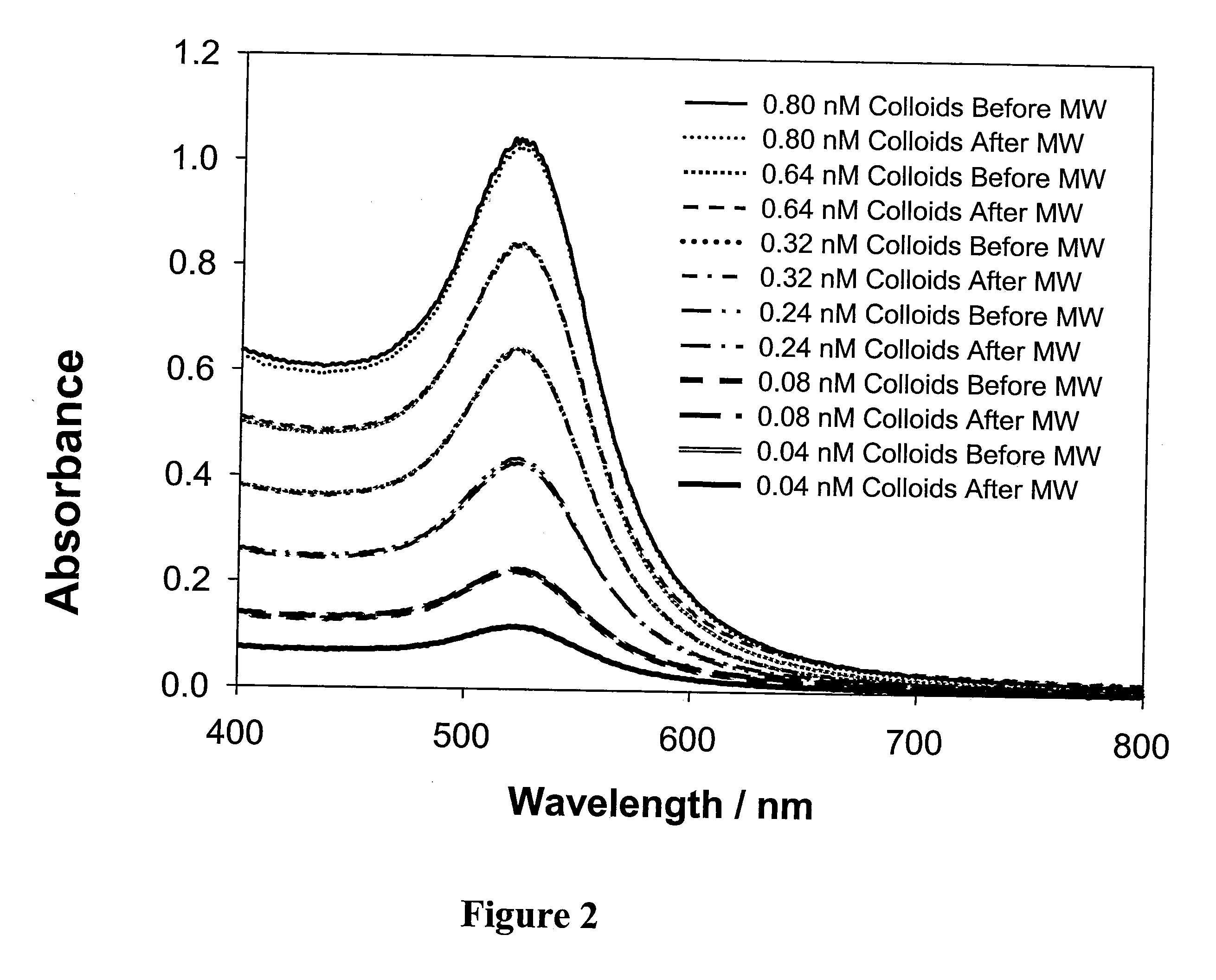Microwave-accelerated plasmonics
a plasmonic and microwave technology, applied in the field of microwave-accelerated plasmonics, can solve the problems of difficult practical use, limited assays and systems discussed hereinabove, and the plasmons are usually non-radiative, so as to improve the method and system, and increase the kinetics of the reaction system
- Summary
- Abstract
- Description
- Claims
- Application Information
AI Technical Summary
Benefits of technology
Problems solved by technology
Method used
Image
Examples
example 1
Materials
[0152]Gold nanoparticle dispersions (monodisperse, either 20 or 10 nm average particle diameter), concanavalin A (Con A from Canavalia ensiformis), dextran (average molecular weight: 64000 and 505000) hydrogen peroxide, sulfuric acid, sodium phosphate monobasic, phosphate-buffered saline (PBS), absolute ethanol, 2-(2-aminoethoxy)ethanol (AEE) and N-hydroxy-2,5-pyrrolidinedione (NHS) were obtained from Sigma. 16-Mercaptohexadecanoic acid (16-MHDA) and polyoxyethylene (20) sorbitan monolaurate (Tween 20), epichlorohydrin, 2-methoxyethyl ether (diglyme), and nitric acid were obtained from Aldrich. N-3-(Dimethylaminopropyl)-N′-ethyl-carbodiimide (EDC) was obtained from Fluka. All chemicals were used as received. Buffers and solutions.
[0153]Sodium phosphate monobasic buffer solution was prepared to a 10 mM concentration at pH 7. PBS was dissolved in deionized water and the pH was adjusted to 7.4. Exact pH values for buffer solutions were obtained using a Beckman pH meter. Deioni...
example 2
[0160]This example illustrates a microwave accelerated plasmonics application in which low power microwaves are utilized in solution based plasmon resonance particle assays.
[0161]As a model protein based system, biotinylated-bovine serum albumin coated 20 nm gold particles, crosslinked by additions of streptavidin (a tetravalent protein), are employed. The model system is schematically shown in FIG. 1, in an illustrative depiction of the gold particles (Au) coated with BSA-biotin, undergoing aggregation in the presence of streptavidin and low level microwave energy input.
[0162]FIG. 2 shows absorption spectra of 20 nm gold colloids as a function of concentration, before and after exposure to low power microwaves. In FIG. 2, a range of different concentrations of 20 nm gold colloids (0.80 nM; 0.64 nM; 0.32 nM; 0.24 nM; 0.08 nM; and 0.04 nM) can be seen. The plasmon resonances are not perturbed by the low power heating, as shown by the close congruence of the respective curves before a...
example 3
[0177]Bovine-biotinamidocaproyl-labeled Albumin (biotinlyated-BSA) and premium quality plain glass microscope slides (75×25 mm) were obtained from Sigma-Aldrich. Quantum dot 655-labeled streptavidin (Qdots-streptavidin) was obtained from Molecular Probes (Eugene, Oreg.). All chemicals were used as received.
Methods
[0178]Preparation of the Metal Films for Surface Plasmon Coupled Luminescence (SPCL) Spectroscopy
[0179]Firstly, the plain glass slide was coated with a 50 nm thick gold film by vapor deposition (EMF Corp., Ithaca, N.Y.). Then, a tape with a 5 mm circular disk is applied onto the gold film and was lifted-off the surface that resulted in the removal of the gold film except a 5 mm circular disk (FIG. 11). Finally, a black electrical tape that is attached to a self-sticking paper, containing a 5 mm wide circular disk (referred to as a “black body”) was attached on the gold-coated glass slide while the two circular disks matched, prior to the assay fabrication and subsequent SPC...
PUM
 Login to View More
Login to View More Abstract
Description
Claims
Application Information
 Login to View More
Login to View More - R&D
- Intellectual Property
- Life Sciences
- Materials
- Tech Scout
- Unparalleled Data Quality
- Higher Quality Content
- 60% Fewer Hallucinations
Browse by: Latest US Patents, China's latest patents, Technical Efficacy Thesaurus, Application Domain, Technology Topic, Popular Technical Reports.
© 2025 PatSnap. All rights reserved.Legal|Privacy policy|Modern Slavery Act Transparency Statement|Sitemap|About US| Contact US: help@patsnap.com



